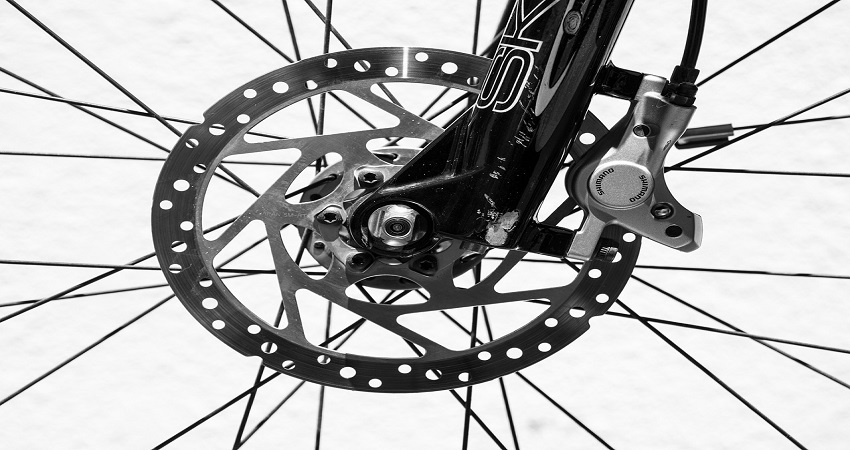Yes, road bikes do have disc brakes. The use of disc brakes on road bikes has become increasingly popular due to their improved stopping power and performance in wet conditions.
In addition to their superior braking capabilities, disc brakes also allow for easier maintenance and provide more consistent braking in different weather conditions. Many road bike manufacturers now offer disc brake options on their models, giving cyclists the choice between traditional rim brakes and the more advanced disc brakes.
Whether it’s for racing, endurance riding, or recreational cycling, road bikes with disc brakes offer cyclists better control and stopping power, making them a preferred choice for riders of all levels.
What Are Disc Brakes?
Road bikes have come a long way in terms of technological advancements and one area where significant improvements have been made is in the braking system. Traditionally, road bikes were equipped with rim brakes, but in recent years, the popularity of disc brakes has been steadily increasing. In this blog post, we will explore the benefits of disc brakes, the different types available, and why they have become a sought-after feature in road bikes.
Disc brakes, as the name suggests, are a type of braking system that uses a disc rotor and caliper to slow down or stop the bike. Unlike rim brakes that apply pressure to the rim of the wheel, disc brakes utilize a rotor mounted on the hub of the wheel. When the brakes are engaged, the caliper squeezes the brake pads against the rotor, causing friction and reducing the speed of the bike.
Advantages Of Disc Brakes
Disc brakes offer several advantages over traditional rim brakes:
- Enhanced stopping power: Disc brakes provide greater stopping power compared to rim brakes, particularly in wet or muddy conditions, making them ideal for road cycling in various weather conditions.
- Consistent performance: Disc brakes offer consistent braking performance regardless of the state of the rim. Unlike rim brakes, which can wear down or heat up during prolonged braking, disc brakes maintain their effectiveness over time.
- Better modulation: With disc brakes, it is easier to modulate the braking power, allowing for more precise control over the bike’s speed. This can be especially advantageous when navigating steep descents or sharp corners.
- Reduced rim wear: The braking force in disc brakes is applied to the rotor, not the rim. This helps reduce wear and tear on the rim, prolonging its lifespan and potentially saving costs on rim replacements.
Types Of Disc Brakes
There are two main types of disc brakes commonly used on road bikes:
- Mechanical disc brakes: These brakes use a cable to actuate the caliper, which then squeezes the brake pads against the rotor. Mechanical disc brakes are generally more affordable and easier to adjust compared to hydraulic disc brakes.
- Hydraulic disc brakes: Hydraulic disc brakes use fluid to transmit force from the brake lever to the caliper. This results in a more precise and responsive braking experience. Hydraulic systems require less maintenance and offer improved modulation and overall performance.
In conclusion, disc brakes have become increasingly popular in road bikes due to their enhanced stopping power, consistent performance, better modulation, and reduced rim wear. Riders now have the choice between mechanical and hydraulic disc brakes, each offering its own set of advantages. Whether you are a recreational cyclist or a professional, disc brakes can greatly improve your riding experience and safety.
Traditional Road Bike Brakes
Road bikes commonly use traditional rim brakes, rather than disc brakes. These brakes work by applying friction to the sides of the wheel rims to slow down and stop the bike.
Traditional road bikes have been equipped with rim brakes for many years. These brakes work by applying friction to the rim of the wheel in order to slow down and stop the bike. Rim brakes are typically found in two types: caliper brakes and cantilever brakes.
Overview Of Rim Brakes
Caliper brakes are the most common type of rim brakes and are mounted directly on the frame of the bike. They feature two arms that squeeze together when you apply the brake lever, causing brake pads to press against the rim. This creates the friction needed to stop the bike. Cantilever brakes, on the other hand, are mainly found on older road bikes and cyclocross bikes. They have two separate brake arms that are connected to the frame or fork via a pivot point. When you engage the brake lever, the arms move inward, causing the brake pads to press against the rim.
Pros And Cons Of Rim Brakes
Rim brakes have been the go-to choice for road bikes for decades, and for good reason. Here are the pros and cons of these traditional brakes:
Pros:
- Lightweight: Rim brakes are generally lighter than their disc brake counterparts, which can make a noticeable difference for riders who prioritize speed and efficiency.
- Cost-effective: Traditional road bike brakes are more affordable than disc brakes, which can be beneficial for cyclists on a budget.
- Easy maintenance: Rim brakes are relatively simple to maintain and adjust. The brake pads are easily accessible and can be replaced without much difficulty.
Cons:
- Reduced stopping power: While rim brakes do an adequate job of slowing down a road bike, they generally have less stopping power compared to disc brakes. This can be a concern, especially for riders who frequently tackle steep descents or need to stop quickly in unpredictable situations.
- Weather-dependent performance: Rim brakes can be affected by wet conditions, as the water on the rims can reduce the friction between the brake pads and the rim surface. This can result in longer stopping distances and less effective braking.
- Wear on the rims: Over time, the constant rubbing of the brake pads against the rim can cause wear and tear on the braking surface. This means that the rims may need to be replaced more frequently than if disc brakes were used.
In conclusion, traditional road bike brakes, or rim brakes, have been the standard choice for many cyclists due to their lightweight design, affordability, and ease of maintenance. However, they do have some drawbacks, such as reduced stopping power and potential performance issues in wet weather conditions.
Disc Brakes On Road Bikes
Road bikes now feature disc brakes, providing riders with better stopping power and control even in wet conditions. With their increased popularity, road bikes equipped with disc brakes offer a safer and more efficient riding experience.
Road bikes have long been synonymous with rim brakes. However, in recent years, there has been a significant shift towards disc brakes on road bikes, driven by advancements in technology and the demand for improved performance and safety. While disc brakes have been prevalent in mountain biking for some time, their adoption in road cycling has sparked debates and discussions among cycling enthusiasts.
Benefits Of Disc Brakes On Road Bikes
Disc brakes bring a host of benefits to road bikes, enhancing both the rider’s experience and the overall performance of the bike. Here are some key advantages:
- Enhanced braking power: Unlike rim brakes, disc brakes operate independently from the wheel rim, allowing for more consistent and reliable braking, even in wet or muddy conditions. This empowers riders to stop quickly and precisely, offering greater control and confidence.
- Improved modulation: Disc brakes enable riders to apply varying amounts of braking force with ease and precision. This results in smoother deceleration, making it easier to navigate tight corners or steep descents.
- Reduced heat buildup: Rim brakes generate heat when braking, which can affect braking performance and potentially damage the rim. With disc brakes, the braking force is distributed evenly across the rotor, reducing heat buildup and minimizing the risk of overheating.
- Consistency in all conditions: Since disc brakes aren’t affected by the weather or debris on the road, they offer consistent performance regardless of the environment. This makes them particularly advantageous for cyclists who venture into diverse terrains and weather conditions.
- Compatibility with wider tires: Road bikes equipped with disc brakes can accommodate wider tires, which provide increased comfort, better traction, and stability on different road surfaces. This added versatility expands the possibilities for road cycling adventures.
Considerations Of Disc Brakes On Road Bikes
While disc brakes undeniably offer numerous benefits, it’s important to consider a few aspects before making the switch:
- Increased weight: Disc brakes and their components tend to be slightly heavier than rim brakes. However, advancements in technology continue to reduce this weight difference, making it less of a concern for many riders.
- Wheel compatibility: Disc brakes require specific wheel sets designed to accommodate the disc rotor. Some road bikes may not have the necessary frame and fork clearances, which can limit the options for upgrading to disc brakes.
- Maintenance and complexity: Disc brakes may require more frequent maintenance compared to rim brakes, especially when it comes to rotor truing and brake pad replacement. Additionally, the hydraulic systems of disc brakes may necessitate more specialized knowledge for repair and adjustment.
- Initial cost: Road bikes equipped with disc brakes are often priced higher than their rim brake counterparts. However, as technology advances, disc brakes are becoming more accessible and affordable to a wider range of cyclists.
Frequently Asked Questions Of Do Road Bikes Have Disc Brakes?
Can Road Bikes Have Disc Brakes?
Yes, road bikes can have disc brakes. While rim brakes were traditionally used on road bikes, disc brakes are becoming more popular for their superior stopping power and performance in wet conditions. Disc brakes allow for more control and precision braking, making them a preferred choice for many road cyclists.
What Are The Benefits Of Disc Brakes On Road Bikes?
Disc brakes offer several benefits for road bikes. They provide consistent and powerful braking performance, even in wet or muddy conditions. Disc brakes also allow for better modulation and control, reducing the risk of skidding or locking up the wheels.
Additionally, disc brakes require less maintenance and are less affected by wear compared to rim brakes.
Are Disc Brakes Suitable For All Road Bike Riders?
Disc brakes are suitable for most road bike riders, as they offer improved braking performance and control. However, it’s important to note that disc brakes may not be necessary for all riders, especially those who primarily ride in dry conditions or on flat terrain.
Ultimately, the decision to use disc brakes on a road bike depends on individual preferences and riding style.
Conclusion
To sum up, the answer is yes, road bikes can have disc brakes. They provide a number of benefits, including better braking performance and increased control, particularly in wet or muddy conditions. While some cyclists prefer traditional rim brakes for specific reasons, disc brakes have become a popular choice in the cycling community.
Whether you’re a beginner or an experienced rider, the decision ultimately boils down to your personal preference and the type of riding you do.



